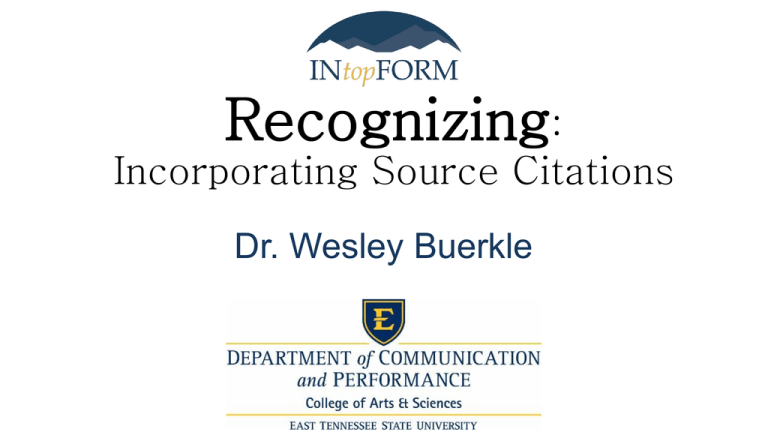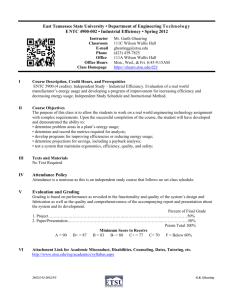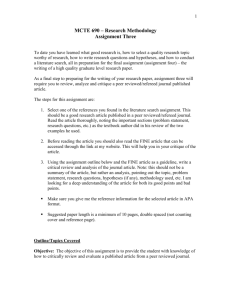PowerPoint
advertisement

Recognizing: Incorporating Source Citations Dr. Wesley Buerkle To Recognize “That’s one!” Give props Where we’re NOT going Textual ownership Non-native English speakers (EL2) Cryptomnesia Intentional Plagiarism Where we ARE going Literature on Inadvertent Plagiarism Study 1: “Why do(n’t) you cite?” Study 2: Using Training Modules Study 3: Peer Modeling What we can do Inadvertent Plagiarism Uncertainty Incompetence Indifference Troublesome “Why do(n’t) you cite?” Students’ Decision Process “Why do(n’t) you cite?” Surveyed 326 ETSU students from gen. ed., oral communication classes Examined likely intent to cite from Expected Outcomes Social Norm Confidence “Why do(n’t) you cite?” Expected Outcomes Citing sources will enhance credibility Social Norm Citing source will enhance my credibility Confidence • (6.2 [1 to 7]) Increasing my credibility is desirable • (2.5 (-3 to +3]) “Why do(n’t) you cite?” Expected Outcomes Teacher Social Norm Classmate Confidence “Why do(n’t) you cite?” Expected Outcomes Social Norm Counterproductive Confidence ?? Using Training * Modules Education Makes a Difference *Funded by a grant from ETSU’s Instructional Development Committee Using Training Modules 308 ETSU students Instructional materials & mastery quiz Required of every student Before first assignment Ticket to ride Using Training Modules Online training (D2L) What constitutes plagiarism Basic elements of a citation Paraphrasing Citations for web sources Using secondary sources Using Training Modules Mastery Quiz (D2L) 12 questions 38 question bank Determined sections (11) Mastery = 100% For a speech on the role of peer pressure in high school students’ decision to drink excessively, which of the following is the MOST appropriate to use in a speech? A. Arata, Stafford, and Tims write in Adolescence, 2003, that “Problem drinkers reported greater susceptibility to peer pressure.” B. An article in Adolescence, a premier journal on teen behavior, contained an article in 2003 that “Problem drinkers reported greater susceptibility to peer pressure.” C. Arata, Stafford, and Tims, respected researchers in the field of psychology, write in 2003, “Problem drinkers reported greater susceptibility to peer pressure.” D. In Adolesence, 2003, pages 567-569, it says that “Problem drinkers reported greater susceptibility to peer pressure.” Using Training Modules Speeches recorded and scored Success! Average 13% improvement Varied widely by instructor Up to 25% improvement Peer * Modeling Students See, Students Do *Funded by grants from ETSU’s Instructional Development Committee & Research Development Committee Peer Modeling 191 students Students saw either a video of an “ETSU student” speech a video of a “Purdue student” speech no video Peer Modeling Speeches recorded and scored Success! Having a model made a difference Seeing the “ETSU student” improved scores Students want to be credible Students are unsure of the how What, then, do we know? Students can learn to recognize Social (classroom) norms matter What We Can Do Possibilities Talk about the Importance of Recognizing Why recognizing is important Ethical Practical (e.g., credibility) Treat recognizing with importance Policy and/or grade Using D2L – TurnItIn Imperfect but very helpful Can help students be more aware Frame as instructional not punitive Literature Review – DRAFT Literature Review – FINAL Focus on Training Spend time on the process Provide examples Require evidence of mastery D2L Quiz Minor assignment In-class exercises Modeling Bad Modeling Better Modeling Books/Articles Books/Articles Minimize recognition Endnotes String citations May not “openly name” researchers Talk about incorporation Examples They Say/I Say Address the readings Their goals Modeling Bad Modeling Better Modeling Lectures Lectures We don’t recognize Recognize sources Unquestioned expert PowerPoint Citation slides Page addresses PowerPoint Recognize • Non-parenthetical Questions Comments Discussion





